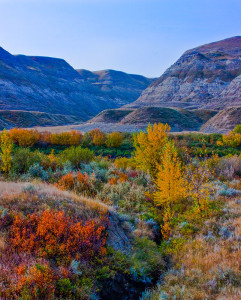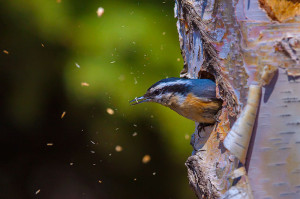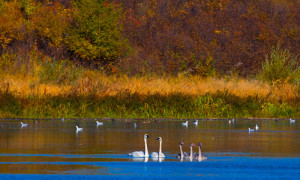 was much jocularity as we spent the weekend hiking, discussing wildlife photography, and photographing this unique corner of Alberta.
was much jocularity as we spent the weekend hiking, discussing wildlife photography, and photographing this unique corner of Alberta.
It was an ideal introduction to nature photography with Dinosaur Park offering a smorgasbord of eye candy for three hungry nature photographers. The park boasts a variety of wildlife and 160 species of birds as well as three distinct topographies, all packed into one relatively small area almost devoid of other campers and hikers, being as it was late September.
Dinosaur Park is a fraction of the Red Deer River Valley. Here, the seemingly endless, unbroken, flat prairie grasslands suddenly part to reveal a massive, winding valley; deep and wide, it is riddled with curious hoodoos and plateaus that cry out to the committed hiker or photographer. Think of it as Alberta’s answer to the Grand Canyon, complete with rattlesnakes and cotton-tail bunnies darting amongst the cacti and sagebrush while falcons, eagles, and vultures soar amongst the towering, sculpted cliffs. Eventually, you can work your way down to the Red Deer River and walk in another world under stands of the great cottonwood trees, remnants of another time, which turn a brilliant gold in the soft September light.
Though it was late September, the nights were warm. I will never forget sleeping under a canopy of giant cottonwood trees with the moon shining boldly, carving intricate silhouettes from the gnarly cottonwood limbs. Magical. I would hear the flutter of each leaf as the wind trickled towards me and then lightly swirled about before wandering off, only to circle back again… yet again. It was so exhilarating that it took quite some time to fall asleep. As it had been a long day of driving and hiking, fatigue eventually overcame exhilaration; I slept hard and awoke to the ‘bumblee’ bees at dawn’s first light, feeling rested and ready to take on another day of photographic pursuits.
Of course, Dinosaur Park is just one of many amazing locales available to us in Alberta and throughout Canada; exploring and experiencing the incredible natural resource that is Canada’s wilderness offers up all the adventure I can handle coupled with the peace and serenity I crave. As John Denver noted, there really is a
When I returned home from Dinosaur Park, it was all I could do to fall asleep; I would close my eyes to find I was still looking through the camera lens. Scene after scene appeared … each time, I instinctively zoomed in to frame the subject which then sprang into focus, followed by the click of the shutter releasing. It wasn’t anything that I was consciously trying to do, nor was I able to stop it or control it. Some of it was a recall of events from the weekend, but most of the imagery I had never seen before. It felt very real, and very intense. Call it photographer’s premonition if you want… but I knew I was hooked.
Soon after, I bought my first SLR camera – a Canon 30D. I put most of my money into a 100-400mm lens as I knew that bird photography would be my area of focus; while I love all God’s critters, and I find myself increasingly interested in landscape photography, birds do hold a special fascination for me. I love the amazing diversity of their colours, patterns, and species; they are endearing and quirky characters and, of course, I am completely envious of their ability to fly. I also think that bird photography is a bit more accessible to someone like me who doesn’t have the luxury of doing wildlife photography full time… it is something I get to do whenever I can manage to squeeze it into my crazy life. Lots of people don’t have the time and/or money to travel to some exotic locale to do landscape photography, or take off to photograph grizzly bears and bald eagles in Alaska. There is, however, quite an abundance of bird life throughout this province, even in towns and cities. (I have taken lots of great bird pictures in my front yard…see bohemian waxwings, red-breasted nuthatches in the Bird Photos gallery. Many of these were taken in my front and back yards.)
 To be sure, wildlife photography is not a gig for the faint of heart. As far as I know, there is not much of a wildlife photographers’ union…the hours suck, there is no overtime, danger pay, or travel allowance. But, in the end, all the perks make it worthwhile: stunning sunsets and sunrises to be savoured, interesting people to meet, mountain highways with jaw-gaping views to drive, gruelling but rewarding trails to hike, and dusty back roads to serendipitously discover.
To be sure, wildlife photography is not a gig for the faint of heart. As far as I know, there is not much of a wildlife photographers’ union…the hours suck, there is no overtime, danger pay, or travel allowance. But, in the end, all the perks make it worthwhile: stunning sunsets and sunrises to be savoured, interesting people to meet, mountain highways with jaw-gaping views to drive, gruelling but rewarding trails to hike, and dusty back roads to serendipitously discover.
 Elk Island National Park is just a few miles from the house where I grew up and about a half-hour east of Edmonton, which has been my home-base for the last twenty-five years. The last 18 years have been well-spent with my adoring, adorable wife who endures and does her best to facilitate and even understand this growing obsession of mine. As a youth, I mostly thought of Elk Island Park as a cheap and convenient place to play golf, but a few decades later I have come to appreciate it for the wonderful wilderness haven it is. It is a setting I now visit regularly for its accessibility, solitude, density of wildlife, and over two hundred species of birds. On a few occasions, I have found myself knee deep in a slough, taking pictures of ducks, swans, or what have you, pondering how curious it is to have returned full circle in this way. Equally curious is that my last name is Marsh.
Elk Island National Park is just a few miles from the house where I grew up and about a half-hour east of Edmonton, which has been my home-base for the last twenty-five years. The last 18 years have been well-spent with my adoring, adorable wife who endures and does her best to facilitate and even understand this growing obsession of mine. As a youth, I mostly thought of Elk Island Park as a cheap and convenient place to play golf, but a few decades later I have come to appreciate it for the wonderful wilderness haven it is. It is a setting I now visit regularly for its accessibility, solitude, density of wildlife, and over two hundred species of birds. On a few occasions, I have found myself knee deep in a slough, taking pictures of ducks, swans, or what have you, pondering how curious it is to have returned full circle in this way. Equally curious is that my last name is Marsh.
Being a wildlife photographer has made me more aware of my surroundings and helped me to develop a greater appreciation of light, perspective, and composition. It has increased my interest in, knowledge of, and interaction with my environment. It has attuned me to the significance of each unique moment. Wildlife photography is a study in perspective, to be sure.
“Be happy for this moment. This moment is your life.” Omar Khayyam
Wildlife photography is a fascinating, demanding, and rewarding discipline with very few limits. As a relative newbie, I am fully aware that I have a steep learning curve ahead of me. In the words of Henri Cartier-Bresson, “your first 10,000 photos are your worst”. So, enjoy the nature photo galleries and check back often as there will be new photos added on a regular basis and, if Henri is correct, the best are yet to come!
Tim Marsh